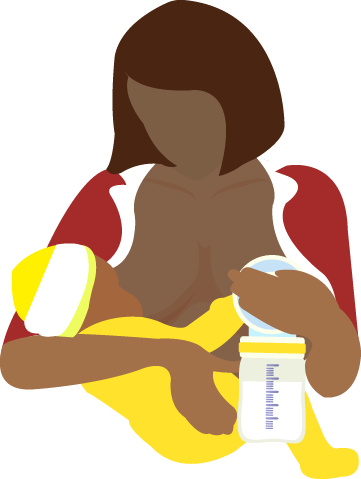
Most women greet with mixed feelings the news that they are expecting twins. Any pregnancy is a time of excitement and joy, but there will also be moments of doubt. You will wonder if the birth will go smoothly, if your babies will be fit and healthy and, especially if these are your first babies or if you have other very young children, about how you will manage. If twins are diagnosed early in the pregnancy, you will have time to work through your conflicting emotions and prepare yourself. As well as bringing much joy to a family, twins can cause additional pressures. Being aware of this possibility however, is the first step in learning to deal with it.
This article is a shortened version of our booklet Breastfeeding:twins, triplets and more in which we have drawn from the experiences of other mothers of twins to put together information and ideas. We hope these will help you deal with the challenges of breastfeeding and parenting your babies.
There are lots of great reasons to breastfeed
In multiple ways, breastfeeding is important for vulnerable babies. It will save you time and a lot of money. The many reasons why breastfeeding is important are detailed in the Australian Breastfeeding Association booklets Breastfeeding: twins, triplets and more and Breastfeeding: an introduction.
Can one woman produce enough milk?
Yes. People sometimes doubt that it’s possible to make enough milk for two babies. Knowing how breastfeeding works will help you understand how this is possible. It can give you the confidence to continue breastfeeding even when your babies are demanding and you, or others, begin to question your milk supply. It will help you keep up a plentiful supply so you can breastfeed for as long as it suits you and your family.
Supply and Demand
The basic rule about milk production is supply = demand. This is a short way of saying that the more often a baby feeds at your breast and removes milk (demand), the more milk is made (supply). This is why mothers of multiples are able to make enough milk for their babies. The extra stimulation of two or more babies sucking means that your body will produce the extra milk they need. Knowing this can help you cope, especially on bad days when your babies seem extra fussy or hungry and you feel like you can’t possibly have enough milk for them. Understanding that supply equals demand can reassure you that those extra feeds your babies are asking for will help you make enough breastmilk to meet their growing appetites. When a baby sucks at the breast, or you express, two hormones are released: prolactin, which stimulates milk production, and oxytocin, which releases the milk from the breast. This release is called the let-down or milk ejection reflex. It is important because it is the mechanism by which the milk is made available to the babies. With the let-down working efficiently, it requires little effort for a small or sick baby to obtain milk.
Expressing
If one or both babies are small, weak and/or premature, you may not be able to breastfeed them at first. You will probably feel disappointed and upset and may begin to doubt whether you will be able to breastfeed your babies at all. Let staff members know how much you wish to breastfeed and ask them to help you get started with expressing. Most mothers find this a time when they need their support people. Surrounding yourself with people who know from experience that breastfeeding in such circumstances is possible, and who are skilled and knowledgeable about how breastfeeding works, is a big help if you are feeling inadequate and discouraged. Their confidence will reassure you of your ability to establish and maintain your milk supply until your babies can feed from your breasts. Start expressing within 24 hours of the birth and ensure that the milk is fed to your babies. Even a small amount of colostrum is valuable, as it will provide nourishment and protection from infection. Express at least as often as you would feed newborn twins, preferably 10-12 times in 24 hours (including at least once at night). Shorter, frequent sessions are better for your milk supply, less tiring for you and gentler on your nipples. For an informative list of how, when and where to express, see our booklet Breastfeeding: expressing and storing breastmilk, or our website article Expressing and Storing Breastmilk
Correct attachment
Regardless of how you feed, your babies need to be correctly attached to the breast. Poor attachment is the most common cause of nipple soreness and may lead to difficulties in supply because a poorly attached baby is likely to feed less efficiently and take less milk at a feed.
Feeding your babies one at a time in the early days will give you a chance to concentrate on one baby and one breast and to learn the signs of correct attachment. This will make it easier for you when you start feeding them together.
The principles are simple but it may take some practice to get it right, particularly if your babies are small and tire quickly. It helps to be relaxed and calm so don’t wait until your baby is ravenous but offer the breast when she first wakes. For information about positioning and attachment, see the Australian Breastfeeding Association booklet Breastfeeding: an introduction, or our website article on attachment.
Be prepared – solving breastfeeding challenges
Reading books about breastfeeding often gives people the impression that it is full of problems. This is not the case. Many women have problem-free lactations. Others have minor difficulties that are quickly overcome. Of course there are women who encounter significant challenges. Most often, these can be overcome with careful assessment, counselling and support. The Australian Breastfeeding Association booklets dealing with many of these topics are mentioned in the text. Your local breastfeeding counsellor will be happy to give you more information.
Source: Australian Breastfeeding Association




